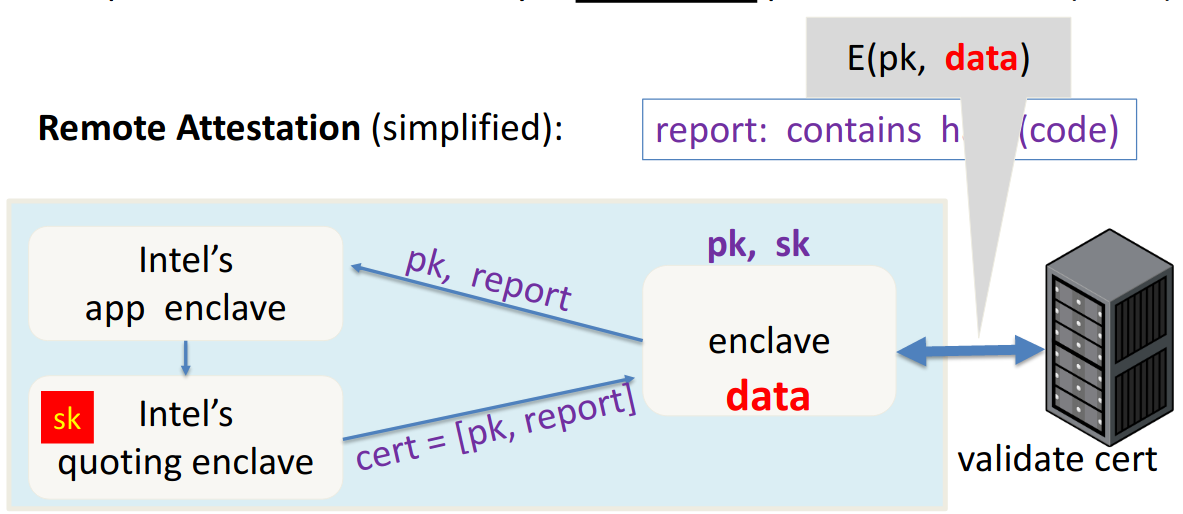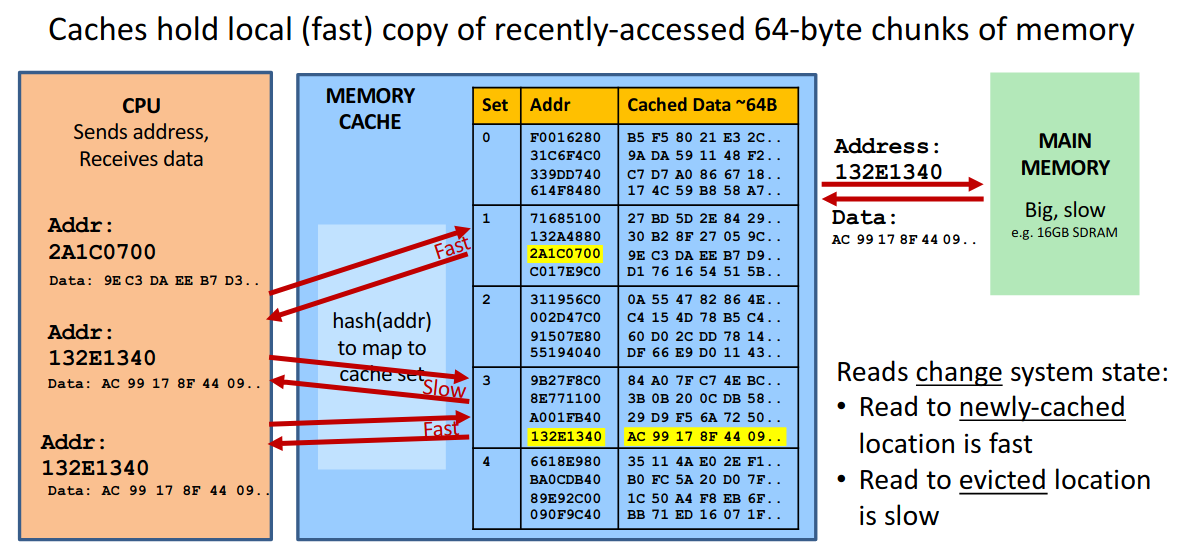Processor security #
The processor #
- Part of the trusted computing base (TCB)
- But is optimized for performance
- Security may be secondary
- Processor design and security:
- Important security features
- Hardware enclaves
- Memory encryption (TME)
- RDRAND
- etc.
- Some features can be exploited for attacks
- Speculative execution
- Transactional memory
- Important security features
Intel Software Guard eXstensions (SGX) #
- Extension to Intel processors that support
- Enclaves: running code and memory isolated from rest of system
- Attestation: prove to local/remote system what code is running in enclave
- Minimum TCB: only processor is trusted and nothing else
- DRAM and peripherals are untrusted
- Writes to memory are encrypted
- Applications
- Storing a web server HTTPS secret key: secret key only opened inside an enclave
- Malware cannot get the key
- Note: this is different from TPM2 - TPM2 only provides secure storage at boot, after that it’s all in memory
- Running a private job in the cloud: job runs in enclave
- Cloud admin cannot get code or data or job
- Client side: hide antivirus signatures
- AV signatures are only opened inside an enclave
- Data science on federated data
- Compute on shared data, without ever having to share the data with anyone else
- SGX now deprecated in consumer CPUs, only available in server CPUs
- Storing a web server HTTPS secret key: secret key only opened inside an enclave
SGX enclaves #
- Application defines part of itself as an enclave
- Untrusted part of memory creates enclave
- Enclave is isolated memory in process memory space
- Inaccessible while processor is not in SGX mode
- Untrusted part can call a trusted function in the enclave
- To do execution, processor goes into SGX mode
- Creating en enclave:
ECREATE: establish mem addr for enclaveEADD: copy memory pages into enclaveEEXTEND: compute hash of enclave contents, 256 bytes at a timeEINIT: verifies that hashed content is properly signed; if so, initializes enclave (signature: RSA3072)EENTER: call function inside enclaveEEXIT: return from enclave
SGX attestation #
- Problem: enclave memory is in the clear prior to activation (
EINIT) - How to get secrets into enclave?

SGX insecurity #
- Side channels: attacker controls the OS, OS sees lots of side-channel info
- Memory access patterns
- State of processor caches as enclave executes
- State of branch predictor
- Extract quoting key
- Attestation: proves to 3rd party what code is running in enclave
- Quoting sk stored in Intel enclave on untrusted machines
- What if attacker extracts sk from some quoting enclave?
- Can attest to arbitrary non-enclave code
- Attestation: proves to 3rd party what code is running in enclave
The Spectre attack #
Background #
- CPU optimizations
- Clock speed maxed out: Pentium 4 (2004) reached 3.8 GHz
- Memory latency is slow and not improving much
- To gain CPU performance, need to do more per cycle
- Reduce memory delays: caches
- Work during delays: speculative execution
- Memory caches
- Hold local (fast) copy of recently-addressed 64-byte chunks of memory

- Hold local (fast) copy of recently-addressed 64-byte chunks of memory
- Speculative execution
- At a branch: CPU will guess that the code will go in one direction and start executing that code while waiting for branch result
- When result comes back, if it is wrong direction, throw away the work and start executing that direction
- Mitigations to the below attacks are still an active area of research
- Other speculative execution attacks also exist (e.g. Meltdown)
Conditional branch (Variant 1) attack #
e.g.
if (x < array1_size)
y = array2[array1[x] * 4096];
- Suppose memory at
array1base is 8 bytes of data that doesn’t matter- Memory at
array1base + 1000: something secret
- Memory at
- Suppose
unsigned int xcomes from untrusted caller - Execution without speculation is safe:
array2[array1[x]*4096]is not evaluated unlessx < array1_size - Before attack:
- Train branch predictor to expect
if()is true: e.g. call withx < array1_size - Evict
array1_sizeandarray2[]from cache
- Train branch predictor to expect
- Attacker calls victim with
x = 1000 - Speculative exec while waiting for
array1_size:- Predict that
if()is true - Read address (
array1base + x)- Using out-of-bounds
x=1000
- Using out-of-bounds
- Read returns secret byte (in cache - fast)
- Brings
array2[BYTE * 4096]brought into the cache - CPU realizes
if()is false, discards speculative work- But leaves
BYTEin the cache
- But leaves
- Predict that
- Attacker (another process or core):
for i = 0...255: measure read time forarray2[i * 4096]- When
i = BYTEread is fast (cached), this reveals the secretBYTE
- Mitigation: speculation stopping instruction (e.g.
LFENCE)- Idea: insert
LFENCEon all vulnerable code paths - Need to do so in a non-manual way that does not compromise performance
- Insertion by smart compiler: supported in LLVM
- Requires compiler to be aware of specific CPU designs
- Idea: insert
Indirect branch (Variant 2) attack #
- Indirect branches: can go anywhere, e.g.
jmp [rax]- If destination is delayed, CPU guesses and proceeds speculatively
- Find an indirect
jmpwith an attacker controlled register- Then cause mispredict to a useful gadget
- Attack steps:
- Mistrain branch prediction so spec-ex will go to gadget
- Evict address
[rax]from cache to cause spec-ex - Execute victim so it spec-runs gadget
- Detect change in cache state to determine memory data